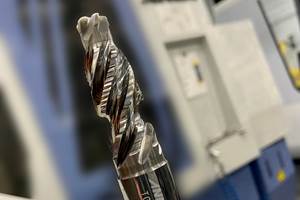Trends That Drive Cutting Tool Development
Cutting tools have highly engineered coatings and geometries for all types of manufacturing methods and materials.
Share





It should be no surprise. Trends in the manufacturing industry drive trends in metalcutting insert development. Changes in workpiece materials, manufacturing processes and even government regulations catalyze parallel advances in metalcutting tooling technology.
As manufacturers continually seek and apply new manufacturing materials that are lighter and stronger—and therefore more fuel efficient—it follows that cutting tool makers must develop tools that can machine the new materials at the highest possible levels of productivity.
By finetuning combinations of tool material compositions, coatings, and geometries, toolmakers enable users to make more parts faster and at reduced manufacturing costs. The development process is continuous and interactive.
Nonferrous Fulfillment
A good example of material-driven tooling development is the growing selection of tools for machining aluminum. In the quest for fuel efficiency, the use of aluminum in vehicle manufacturing is constantly increasing. While in 1980 aluminum made up approximately 3 percent (representing 34 kg/75 lbs) of a typical midsize car, that proportion had risen to about 5 percent by 1990. Forecasts for cars of the future indicate that aluminum usage will rise to between 10 percent and 20 percent of the total vehicle weight, with engine blocks, cylinder heads, and housings being major contributors to consumption.
Although uncoated carbides and polycrystalline diamond tools presently dominate the turning, milling and drilling of aluminum/silicon alloys, the increasing aluminum usage has hastened the development of thinfilm diamondcoated carbide cutting tools (Figure 1, at left). Diamondcoated tools offer wear resistance comparable to polycrystalline diamond materials, while also providing multiple insert edges and the ability to support complex chipcontrol geometries. The dual advantages of high wear resistance and geometric flexibility make diamondcoated tools excellent candidates to replace uncoated carbides as well as expensive PCD cutting tools. Diamond coating is being extended to more difficult tool geometries including drills and end mills. And, for hypoeutectic aluminum as well as magnesium alloys, titanium diboride (TiB2) coatings applied by the physical vapor deposition (PVD) process offer productivity advantages (Figure 2, below).
New Irons In The Fire
Gray cast iron, another mainstay of vehicular manufacturing, frequently is being replaced by stronger, tougher nodular cast irons in components such as housings, crankshafts and camshafts (Figure 3). However, the strength and toughness that make nodular irons desirable workpiece materials also make them difficult to machine. Tools to machine these irons must resist abrasive wear and endure interruptions in the cut, as well as be capable of productive cutting speeds and feed rates.
Nodular irons typically would be machined with carbide inserts featuring chemicalvapordeposition (CVD) coatings. CVD coatings have been commercially available for about 30 years, and the fact that more than half of the inserts sold are CVDcoated testifies to the effectiveness of these coatings. However, the high temperatures (about 1,000°C) involved in the CVD process create an embrittlement called “eta phase” at the coating/substrate interface. Depending on its extent, the embrittlement can affect performance in operations involving interruptions of cut and inconsistency of workpiece microstructure such as found in some nodular irons. Recently developed mediumtemperatureCVD (MTCVD) coatings have shown a reduced tendency to formation of eta phase. MTCVDcoated tools offer increased resistance to thermal shock and edge chipping compared to conventional CVDcoated tools. The result is greater tool life as well as increased toughness compared to hightemperature CVD coatings.
Sharp for Steel . . . and Others
Physical-vapor-deposition (PVD) coatings also offer advantages over CVD coatings in certain operations and/or workpiece materials. Commercialized in the mid1980s, the PVD coating process involves relatively low deposition temperatures (approximately 500°C), and permits coating of sharp insert edges. (CVDcoated insert edges are usually honed before coating to minimize the effect of eta phase.) Sharp, strong insert edges are essential in operations such as milling, drilling, threading and cutoff, and for effective cutting of longchipping materials such as lowcarbon steels (Figure 4, at below). In fact, a wide range of “problem” materials—such as titanium, nickelbased alloys, and nonferrous materials—can be productively machined with PVD coated tools. From a workpiece structure point of view, sharp edges reduce cutting forces, so PVD coated tools can offer a true advantage when machining thinwalled components.
The first PVD coatings were titanium nitride (TiN), but more recently developed PVD technologies include titanium carbonitride (TiCN) and titanium aluminum nitride (TiAlN), which offer higher hardness, increased toughness, and improved wear resistance. TiAlN tools in particular, through their higher chemical stability, offer increased resistance to chemical wear and thereby increased capability for higher speeds.
Recent developments in PVD coatings include “soft” coatings such as molybdenum disulfide (MoS2) for dry drilling applications. Combination soft/hard coatings, such as MoS2 over a PVD TiN or TiAlN, also show great potential, as the hard (TiN or TiAlN) coating provides wear resistance while the softer, more lubricious outer layer expedites chip flow.
Running Dry
Government mandates also can affect cutting tool development. In some countries, increasingly strict environmental regulations governing the disposal of cutting fluids are resulting in increased use of dry machining. While dry machining is not appropriate for every process and workpiece material, in some cases careful selection of cutting tool material can enable a user to minimize or avoid the use of coolant. A cutting tool with a thick alumina coating can allow increased feed rates in the machining of steel, reducing contact time of the insert with the workpiece and minimizing exposure of the tool to high cutting temperatures, and thereby enabling productive dry machining (Figure 5, below). In addition, advanced coatings such as PVD TiAlN can provide good performance in dry machining or in minimal coolant systems. As mentioned previously, lubricious PVD MoS2 coatings can also facilitate dry drilling and tapping. A focus on dry machining will spark further effort to develop cutting tools with high resistance to thermal load.
Cermets For NearNet
Cermet cutting tools (also effective in dry machining applications) are one facet of the cutting tool industry’s response to nearnetshape manufacturing trends. These trends entail efforts to lower manufacturing costs by casting and forging components to near their final (net) shape, thereby reducing the number of machining operations necessary to complete a part. Fewer heavy roughing operations are required, and the need for tools engineered for semifinishing to finishing duty expands. Development of cermet tools is one way tool manufacturers are addressing this need. Cermets, comprised mostly of titanium carbonitride (TiCN) with a nickelcobalt binder, are hard and chemically stable, leading to high wear resistance. Cermets work best in materials that produce a ductile chip, such as steels and ductile irons. Their increased speed capability enables them to machine carbon, stainless steels and ductile irons at high speeds while producing excellent surface finishes.
Recently developed cermets combine excellent resistance to deformation and chemical wear with a degree of toughness that enables them to be used in semifinishing as well as finishing operations. PVD coatings further enhance the performance of cermets on a wide variety of workpiece materials.
Machining The Hard Way
Both environmental/governmental factors (disposal of coolant/swarf) and economic concerns (the high cost of grinding) are accelerating the replacement of grinding by machining in the processing of hardened workpieces. The cutting tool industry is constantly developing and evaluating tools engineered to provide maximum productivity in hard-machining operations. These tools include superhard materials such as polycrystalline cubic boron nitrides, as well as ceramic tools.
Coatings, which reduce frictional heat and promote longer tool life, are among the new concepts being utilized in tools for hard turning (Figure 6, at left).
In field tests, coated superhards have outlasted other PCBN tools by 20 to 100 percent. Coatings have also proven effective on ceramic tools engineered for hard turning. In situations where the hardened workpiece doesn’t have roughness or other interruptions, coated ceramics offer more cutting edges and lower cost, and can be a costeffective alternative to PCBN tools in hard turning.
Updated Ceramics For Difficult Materials
Development efforts in ceramic tool technology are enabling these hightech tools to move into new areas of application. While recently developed silicon nitride tools offer improved fracture resistance compared to their predecessors, their relatively low resistance to chemical wear has limited their use in the machining of nodular cast irons (Figure 7, below). However, wearresistant CVD alumina coatings have expanded the application range of siliconnitridebased tools to include these difficult tomachine irons.
Regarding alumina (A1203based) ceramics, the addition of silicon carbide whiskers offers increased productivity in the machining of Inconel and similar highstrength, hightemperature alloys in the aerospace industry. Singlecrystal whiskers deflect cracks in the alumina matrix and thereby improve fracture toughness of the tool.
Geometric Progression
Perhaps the common thread through all manufacturing is the drive for increased productivity and reliability. As metalcutting operations become increasingly finetuned, the relationship between cutting tool micro (cutting edge preparation) and macro (rake face topography) geometry is becoming more and more important. Chip control, tool life, workpiece finish and accuracy can be greatly improved by applying the proper combination of micro and macro geometries in conjunction with the proper substrate and coating. Control of the chip, dissipation or deflection of heat via restricted contact topographies, and reduced cutting forces as a result of positive rake surfaces all lead to the improved performance of today’s modern molded cutting insert geometries. Advances in tool manufacturing technology are making possible more precise matching of macro geometries and hones to specific machining applications.
Productivity First
True breakthroughs in cutting tool technology occur, but they are rare. Most tool development comes from development, refinement and innovative combinations of existing tool materials. The direction for this development begins with the analysis of the characteristics of the materials being machined, includes the demands of specific operations, and involves ongoing communication between toolmaker and end user. MMS
About the author: David B. Arnold is the vice president and chief technical officer for Kennametal Inc.
Related Content
Emuge-Franken End Mill Wins ANCA's Tool of the Year Award
Emuge-Franken received the award for its specialized tool based on the new Cera-Cut end mill design.
Read MoreNidec Universal Head Enables Versatile Machining
The compact universal head enables better accessibility between the tool and the workpiece, as well as improved surface-finish quality, greater motion range and high-efficiency machining under ideal machining conditions.
Read MoreBig Daishowa Chuck Eliminates Chatter in Milling Operations
The Mega 12DS chuck is designed for trochoidal milling with anti-vibration end mills.
Read MoreGWS Tool Group End Mill Provides Dynamic Milling
Eastec 2023: The Hurrimill AT4 all-terrain end mill features radial-end gashing, which enables drilling, steep ramping and aggressive helical entry.
Read MoreRead Next
Building Out a Foundation for Student Machinists
Autodesk and Haas have teamed up to produce an introductory course for students that covers the basics of CAD, CAM and CNC while providing them with a portfolio part.
Read More5 Rules of Thumb for Buying CNC Machine Tools
Use these tips to carefully plan your machine tool purchases and to avoid regretting your decision later.
Read MoreRegistration Now Open for the Precision Machining Technology Show (PMTS) 2025
The precision machining industry’s premier event returns to Cleveland, OH, April 1-3.
Read More











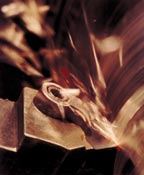
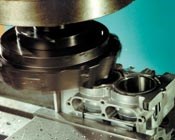
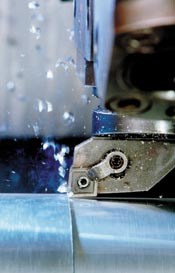
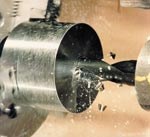
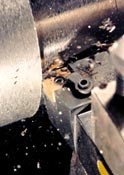
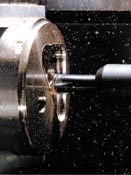
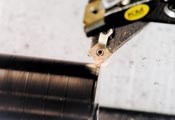






.png;maxWidth=300;quality=90)




